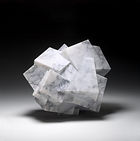on my language of forms
Obviousely, mankind has passed down something like a canon of forms and ideas which in the language of genetics correspondingly would be the phenotype. Nevertheless, for the individual sculptor it is important to shape the authentic personal content... My idea is to create metaphorical and symbolic forms which positively bear a visible vivid tension and power, which could be that the sculpture itself appears to be breathing, or it might be breathtaking for the beholder.

ladder
The ladder serves as a bridge between heaven and earth, as a symbolic path from the earthly to the divine. It is a metaphor for the heavenly desire for lively communication between man and god, a pathway to eternity. During the ascent, mankind moves from one level to the one above, can cross the line to a higher level of consciousness or even access the unconscious.
In mining, ladders are referred to as paths – the ladder can also be seen as an image for the journey itself. This does not however signify a mere climbing trip into paradise. Anyone wishing to progress upwards has to be prepared for a difficult path filled with danger. Benedict of Nursia describes the 12-runged Jacob’s Ladder as the ladder of virtue, as man’s steps towards an internal holism.

spiral
The spiral is a universal artistic intervention of nature. On the microscopic to small scale it manifests itself as the perfect package for hereditary information, as spirilla bacteria or as a snail’s shell. Moved by physical powers, a spiral-formed water jet is created or a macro-cosmic construction in which remote stars form a spiral nebula. In all cultures it is an ancient, holy symbol of creation and the universe, a symbol for the cycles of development, renewal and evolution in the mystic, cosmic sense.
Whatever the phenomenon, be it a functional two-dimensional building plan, a 3-D giant screw or Bronze Age motifs, the spiral form offers a wide range of aesthetic shapes which have been used in art and architecture throughout the ages.

crystal
Crystals have always wielded a continual fascination on mankind. This may be due to their particular geometry and symmetry, or even to their material properties. The crystal unites opposites: it can be well-proportioned and comprehensible as well as distorted and bizarre; it is translucent, letting clear light through, but can also confuse darkly and diffusely. The crystal is a metaphor for locked complexity on the one hand and shimmering transparency on the other. It embodies order and chaos to equal degrees.
Because of the polarity of its characteristics the crystal has a peculiarity beyond that of other materials. This makes it an object of study in geometry and mineralogy, the touchstone for alchemy and arcane lore, the concentrate for philosophy and art. In religions, myths and legends, the crystal appears as happiness, wealth, might or a force promising eternal youth. As the legendary `Stone of Wisdom´ it represents the projection of the universal formula, it is the quintessence of life.

tower
Man has always felt the need to build towers, starting as a child stacking building blocks. The tower does not just appear as a real construction, such as the Leaning Tower of Pisa, the Eiffel Tower or the former World Trade Center. It is also a central feature of many stories, such as the Tower of Babel, and of particularly significance in fairy tales. Towers can be built in many ways and for many reasons but they all have one thing in common: they tower towards heaven.
The significance of the tower is allegorical: it embodies man’s desire to become godlike, his yearning for paradise, for eternity. It is a representative of power, of defence and pride, it is a signpost and a symbol of urbanity. Against this background, constructions such as the towers of medieval Italy, cathedral towers, pagodas, obelisks need no explanation. The tower is, and always has been, all through the ages, an universal icon which is understood intuitively.

knot
The great Ashley Book of Knots encompasses around 3,800 different knots and illustrates what they look like, what they are used for and how they are tied. Ordered according to profession, action, and function, there are many practical knots, but also ornamental ones or mere curiosities. Art History can tell us about knots with varied symbolism. They represent the mysterious, the fascinating. It is easy to understand that for our forefathers, the everyday handling of knots was also a ritualised act. Reduced to their essence, the symbolism of knots throughout the History of Art can be characterised as follows: A connection of the eartlhy to the heavenly, an image of strength and resistance, in order to simultaneously ward off evil powers and to bind positive ones; something worthy of protection, a representation of infinity, eternity; an image for the path of life, for love, power and dominion, for the Trinity.
The love knot features in history as a typical dowry gift, for example in carvings on linen trunks and chairs or woven into table cloths. It is meant to protect the marriage. Over centuries seamen developed a number of knots, partly as finger exercises during long sea journeys, partly as a means of communication when they were not able to write the language. They also sent messages in the form of knots.
Astonishingly, our modern society understands hardly anything of the mystical meaning of the knot motifs. Yet if we think of the international connections of digital networks or the construction of complicated motorway intersections, whose aerial images give the appearance of interwoven patterns, the great standard volume of knots could easily be expanded by a few more chapters.


